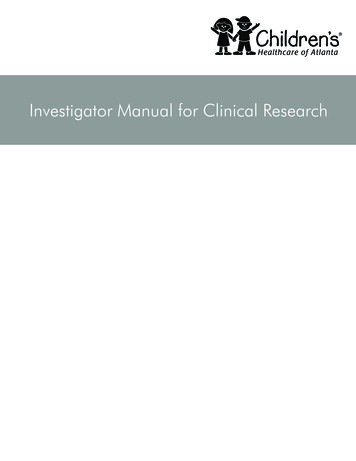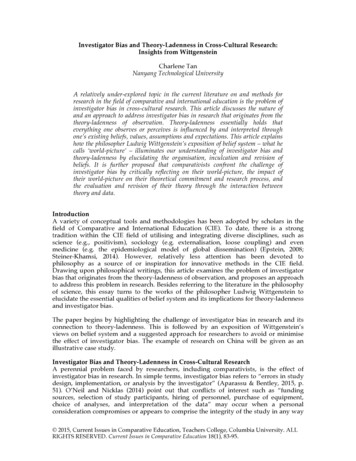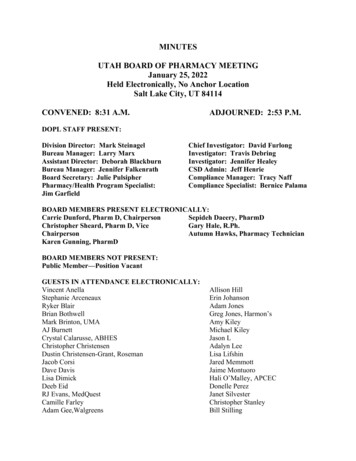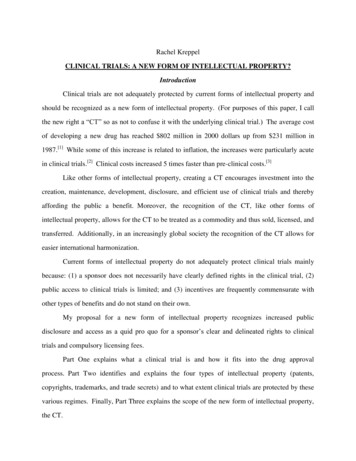
Transcription
Investigator Manual for Clinical Research
SECTION I. Introduction1.0 Defining Human Research1.1 Human Subject Research1.2 Research Roles2.0 Regulations and Ethical Considerations2.1 Federal Regulations2.2 Federal Agency Oversight2.3 Ethical Considerations2.4 Vulnerable Populations2.5 Risks to Subjects2.6 Conflicts of Interest3.0 The Children’s Healthcare of Atlanta Research Infrastructure3.1 Human Research Protection Program3.2 Core OfficesSECTION II. Study Preparation4.0 Study Feasibility Assessment4.1 Scientific Validity4.2 Resource Assessment4.3 Recruitment Potential4.4 Financial Feasibility5.0 Education and Training5.1 Required Research Training5.2 Additional Training Opportunities5.3 Professional Research Associations6.0 Grant Writing6.1 Types of Grants6.2 Components6.3 Grant Revisions7.0 Research Methods and Statistical Design7.1 Basic Elements of Study Design7.2 Basic Types of Study Design7.3 A General Guide to Statistical Consultation7.4 Basic Statistical Terms8.0 Protocol Design/Review8.1 Elements of a Study Protocol8.2 IRB Review8.3 Study Flowchart9.0 Research Involving Drugs and Devices9.1 Investigational Drug Studies9.2 Investigational Device Studies9.3 Investigator’s Brochure10.0 Research Involving Human Tissue10.1 Tissue Repository at Children’s10.2 Tissue Bank at EmoryPage 4343537383940414142424445464647
11.0 Monitoring Plan Development11.1 Roles11.2 Scope11.3 Timing12.0 Case Report Form Development12.1 Content, Organization and Format12.2 Tips for Creation12.3 Electric Data Capture (EDC)13.0 Informed Consent Form Development13.1 General Writing Tips13.2 Elements of Informed Consent13.3 Informed Consent Template13.4 Assent14.0 Health Insurance and Accountability Act (HIPAA) Authorization14.1 Overview14.2 HIPAA Authorization Form14.3 IRB Exemption/Waiver of HIPAA Authorization15.0 Subject Recruitment Plan15.1 Considerations for Subject Payments15.2 Privacy Rules Regarding Subject Recruitment15.3 Clinical Trials Web Posting16.0 Institutional Review Board Submission16.1 The Children’s IRB Review16.2 Determining Review Type16.3 Submission Requirements16.4 IRB Post-review Actions16.5 External Institutional Review17.0 Other Children’s Reviewing Entities17.1 Conflict of Interest Committee (COIC)17.2 Radiation Safety Committee (RAC)17.3 Clinical Engineering18.0 Study Finances and Contracts: Pre-award Process18.1 Study Budget Development18.2 Final Approval of Budgets18.3 Contracts18.4 The Children’s Final Approval Process18.5 Notice of Award19.0 Site Implementation19.1 Site Selection for Multicenter Studies19.2 Site Orientation19.3 Site 626364646566666767677172727475767778787980
SECTION III. Research Project Management20.0 General Guidelines of Study Management20.1 Tracking Key Parameters20.2 Study Management Meetings21.0 Study Documentation Management21.1 Regulatory Binder—General21.2 Regulatory Binder—Additional Element for Drug and Device Studies21.3 Manual of Operations21.4 Financial Documents22.0 Data Management22.1 Data Dictionary22.2 Creating the Study Database22.3 Testing22.4 Statistical Analysis22.5 Location of Database22.6 Transfer of Information23.0 Investigational Product Inventory23.1 Background and Purpose23.2 Contacting Investigational Pharmacy Services23.3 Dispensing23.4 Documentation24.0 Adverse Event Management24.1 Definitions24.2 Documentation24.3 Reporting Serious Adverse Events25.0 Data Safety Monitoring25.1 Data Safety Monitoring Boards26.0 Protocol Modifications26.1 Protocol Amendments26.2 Protocol Deviations and Violations26.3 Premature Discontinuation of a Study27.0 Continuing Review/Renewal27.1 IRB Continuing Reviews28.0 Financial Accounting: Postaward Process28.1 Coordinating the Project28.2 Patient Care Invoicing28.3 Grants Accounting at Children’s28.4 Process for Payment by Sponsors28.5 Grants Accounting at Emory29.0 Audits29.1 Audit Procedures29.2 Audit Areas29.3 Common 07107107108109
SECITON IV. Subject Management30.0 Screening30.1 Gathering Information30.2 Documentation31.0 Consenting31.1 Underlying Principles31.2 Obtaining Informed Consent31.3 Reconsenting32.0 Enrollment32.1 Implementation32.2 Documentation32.3 Tracking33.0 Study Procedures33.1 Subject File33.2 Registering/Scheduling Procedures33.3 Conducting Visits33.4 Payment Procedures33.5 Accessing Medical Records34.0 Subject Retention and Attrition34.1 Retention Strategies34.2 Withdrawing a Subject34.3 Lost to Follow-up (LTF)35.0 Managing Adverse Events35.1 Assessing Adverse Events (AE)35.2 Clinical ManagementSECTION V. Study Closeout36.0 Final Reconciliations36.1 Reconciling Investigational Product Inventory36.2 Database Finalizations37. Post-study Communication37.1 Institutional Notifications37.2 Final Reports38. Storage and Archiving38.1 Study Record Retention38.2 Human Tissue Retention39. Publications and Presentations39.1 Publication Rights39.2 Responsible Authorship39.3 Journal Submission39.4 Poster Presentation40. Intellectual Property40.1 Definition40.2 Categories of Intellectual Property40.3 Intellectual Property Ownership at Children’s40.4 Intellectual Property Protection 121122122122123123123123124125125125126126126
AppendixAppendix A: Investigational New Drug (IND) Application ProcessA-1 to A-7Appendix B: Informed Consent Submission, Revision and Approval GuidanceAppendix C: Consent FormB-1 to B-3C-1 to C-5Appendix D: NIH HIPAA Privacy Rule Information for ResearchersAppendix E: Advertising for Study Subject Recruitment GuidanceD-1 to D-22E-1 to E-3Appendix F: Obtaining and Maintaining IRB Approval GuidanceAppendix G: Handling IRB CorrespondenceF-1 to F-3G-1 to G-2Appendix H: Negotiating Research Contracts GuidanceAppendix I: Amendments to the Research Contract GuidanceH-1 to H-2I-1 to I-2Appendix J: Letters of Agreement GuidanceAppendix K: Serious Adverse Experience Reporting GuidanceAppendix L: Product Adverse Event/Device Malfunction Reporting GuidanceAppendix M: Policy of the National Cancer Institute for Data and Safety Monitoring ofClinical TrialsAppendix N: Managing Protocol Amendments GuidanceJ-1 to J-2K-1 to K-3L-1 to L-2M-1 to M-5N-1 to N-3Appendix O: Handling Sponsor, QA or IRB-Initiated AuditsAppendix P: Handling Monitoring Visits GuidanceO-1 to O-1P-1 to P-3PoliciesInstitutional Review Board Standard Operating ProcedureResearch ContractingPatient Care Budgeting for Sponsored ResearchIntellectual Property PolicySponsored Research BudgetsEffort ReportingInvestigational Drugs, Biologics and Dietary Supplements in ResearchInvestigational DevicesData and Safety Monitoring of Clinical Research StudiesConflict of Interest Related to ResearchResearch Adverse Event ReportingEmergency Use of Investigational Drugs, Biological Products and DevicesAssent and Legally Authorized Representative Permission in Pediatric ResearchUse of Human Biological Materials in ResearchOral Interpretation for Limited English Speaking (LES) Persons and Written Translation of ConsentForms for ResearchInformation Management, Electronic File Naming PolicyUses and Disclosures for Research Purposes and Waivers (HIPAA Research Policy)Document Retention and DestructionResearch Record Storage, Retention and Disposition of Documents/RecordsReporting Noncompliant Conduct in ResearchPrepared by The Children’s Healthcare of Atlanta Clinical Research Department. May 2008.Children's Healthcare of Atlanta has not reviewed the entire content of third party Web sites and/orresources listed in this manual and does not make any representations regarding their content oraccuracy.
Section I1.0IntroductionDefining Human Research1.11.2Human Subject ResearchResearch Roles1.1HUMAN SUBJECT RESEARCHDefinition of TermsChildren’s Healthcare of Atlanta (Children’s) adopts the federal Department of Healthand Human Services (DHHS) and Food and Drug Administration (FDA) regulatoryterminology for defining human subject research, as follows:“Research” is a systematic investigation, including research development, testing andevaluation, designed to develop or contribute to generalizable knowledge(45§46.102(d)). Examples of systematic investigations include: Clinical trials of drugs or devices Medical outcomes study comparing approved drugs or devices Surveys and questionnaires Interviews and focus groups Analyses of existing data or biological specimens Epidemiological studies Evaluations of social or educational programs Cognitive and perceptual experiments Medical chart review studies“Human subject” means a living individual about whom an investigator (whetherprofessional or student) conducting research obtains (1) data through intervention orinteraction with the individual, or (2) identifiable private information (45§46.102(f)). Thismay be an individual who is or becomes a participant in research, either as a recipient ofthe test article or as a control. A subject may be either a healthy human or a patient(21§50.3(g)). “Intervention” includes both physical procedures by which data are gathered (forexample, venipuncture) and manipulations of the subject or the subject’senvironment that are performed for research purposes (45§46.102(f)). “Interaction” includes communication or interpersonal contact betweeninvestigator and subject (45§46.102(f)). “Private information” includes information about behavior that occurs in a contextin which an individual can reasonably expect that no observation or recording istaking place, and information which has been provided for specific purposes byan individual and which the individual can reasonably expect will not be madepublic (for example, a medical record). Private information must be individuallyidentifiable (i.e., the identity of the subject is or may readily be ascertained by theinvestigator or associated with the information) in order for obtaining theinformation to constitute research involving human subjects (45§46.102(f)).1
“Test article” means any drug (including a biological product for human use),medical device for human use, human food additive, color additive, electronicproduct or any other article subject to regulation from the Public Health ServiceAct (21§50.3(j)).Research results do not have to be published or presented at a professional meeting tobe defined as human subject research. The intent to contribute to “generalizable(scholarly) knowledge” makes an activity research, regardless of publication. Researchthat never is published is still research.All human subject research activities in which Children’s is engaged, regardless ofsponsorship and overall intent, must be submitted to the Children’s Clinical Researchdepartment through the Children’s Institutional Review Board (IRB) office. The humansubject research may not be initiated until approval is issued by the Children’s Directorof Clinical Research, Manager of Operations and Finance, and the appropriate IRB(s).1.2RESEARCH ROLESResearch Roles and ResponsibilitiesHuman subject protection is a shared responsibility of all individuals and organizationsinvolved in research. These entities include the federal agencies that enforce the humansubject research regulations, the institutions engaged in human subject research, theIRBs reviewing the human subject research and the investigators conducting the humansubject research. The roles and responsibilities of these different entities are defined infederal and state laws and regulations pertaining to human subject research.Summary:Institution Children’s bears responsibility for compliance with the DHHS and FDA regulationsfor the performance of all human subject research activities in which it is engaged. Children’s is required to use additional safeguards for research in vulnerablepopulations (e.g., children). This is true for research conducted at sites managedwith the direction of any employee or agent of Children’s. Children’s has responsibility for educating researchers on issues of research ethicsand scientific integrity. Children’s has a mandated responsibility to investigate alleged cases of scientificmisconduct. In addition, Children’s has a responsibility to have and enforce a policyon conflict of interest. Children’s has responsibility for establishing and maintaining procedures to ensureappropriate ethical review of research proposals by the IRB, administrative review ofresearch protocols, contracts and grants by the Clinical Research department, andscientific peer review as needed.Signatory Official Allocates necessary resources to the human subject protection program to ensure itssuccess. Completes the training requirements for education in human subject protection. Has regular communication regarding the status of the human subject protectionprogram and, as necessary, individual studies.Institutional Review Board (IRB)2
Ensures compliance with the Children’s policies and procedures, federalregulations, and state and local laws relative to the review of human subjectresearch studies.Reviews all research activities involving human subjects and documents thefindings regarding ethical considerations, scientific merit, and adherence tofederal regulations and IRB policies and procedures.Reviews research activities to ensure that:o Risks to subjects are minimized by using procedures that are consistentwith sound research design and that do not unnecessarily exposesubjects to risk, and whenever appropriate, by using procedures alreadybeing performed on the subjects for diagnostic or treatment purposes.o Risks to subjects are reasonable in relation to anticipated benefits, if any,and to the importance of the expected knowledge. In evaluating risks andbenefits, the IRB considers only those risks and benefits that may resultdirectly from the research (as distinguished from risks and benefits thatpeople would have even if not participating in the research); ando Selection of subjects is equitable. In making this assessment, the IRBtakes into account the purpose(s) of the research and the setting in whichthe research will be conducted;o Informed consent is obtained from the subject or the subject’s legallyauthorized representative and appropriately documented, unless waivedin accordance with applicable federal regulations;o Where appropriate, the research plan makes provisions for monitoring thedata collected to ensure the safety of subjects; ando Where appropriate, there are provisions to protect the privacy ofparticipants and to maintain the confidentiality of data.o Where appropriate, additional safeguards are included in the study toprotect the rights and welfare of subjects when some or all of them arelikely to be vulnerable to coercion or undue influence (children, prisoners,pregnant women, handicapped, mentally disabled persons, oreconomically or educationally disadvantaged persons).Reviews research protocols and is authorized to approve, require modificationsto secure approval, disapprove, and terminate or suspend.Conducts continuing reviews of approved research. Reviews proposedamendments, adverse events, protocol deviations and matters of noncompliance.Has the authority to:o Require research progress reports;o Audit and/or monitor the research and researchers for adherence to thefederal regulations, Children’s policies and IRB policies and procedures;ando Report suspensions, terminations, and noncompliance to IRB officials, theChildren’s officials, research administrative (RA) officials, and the federalgovernment.Completes all training requirements and stay informed of current researchrelated and regulatory developments.IRB Administrative Staff With the IRB, responsible for maintaining the Children’s Federal Wide Assurance(FWA) and for ensuring compliance with its terms.3
Responsible for compliance with the Children’s policies and procedures, federalregulations, and state and local laws relative to the conduct of human subjectsresearch studies.Provides guidance regarding the interpretation of regulations, laws, and policiesto the organization‘s researchers, staff and administrators.Develops and implements the Children’s human subject protection policies andprocedures.Completes all required human subject protection training requirements and, ifapplicable, Health Insurance Portability and Accountability Act (HIPAA) training,and ensures that investigators and key study personnel complete requiredtraining.Responsible for providing opportunities for human subject protection training toinvestigators, key study personnel, the Signatory Official, and all the Children’sstaff who participate in the human subject protection program.Performs quality assurance monitoring of research protocols and investigatesmatters of noncompliance. Implements corrective action as needed inaccordance with the Children’s policies and IRB policies and procedures.Monitors federal regulatory Web sites and other research-related resources tostay current with regulatory changes in human subject protection guidelines andpolicies. Communicates pertinent information to staff in a timely manner.Maintains all study-related documentation in accordance with the Children’spolicies, IRB policies and federal regulations.Principal Investigator (PI) Oversees and conducts the research process and is responsible for the conductof the investigators and research staff at all study sites for which he/she is listedas the Principal Investigator. Ensures compliance with research protocols, and applicable federal, state, andlocal laws and regulations, the Children’s policies, and IRB policies andprocedures. Responsible for the safety and welfare of subjects. Ensures compliance with the protocol’s data and safety monitoring plan, andreports adverse events to the IRB, study sponsor and appropriate federalagencies. Ensures that informed consent is appropriately obtained from all subjects andthat subjects are treated with respect and dignity. Completes all required human subjects protection training, and, HIPAA training,and ensures that investigators and key study personnel complete requiredtraining. Reviews all IRB policies and procedures as part of the required initial training forconducting human subject research. Routinely reviews the IRB Web site for newor revised IRB policies and procedures. Reviews scientific literature to ensure that protocol interventions are consistentwith current research data and do not place subjects at unnecessary risk. Is responsible for the adequacy of all submissions to the IRB including protocolapplications, amendments and adverse event reports. Ensures the timely continuing review of protocols and the submission of all reapproval applications before the protocol’s expiration date. Reports protocolexpirations promptly to the IRB.4
Submits proposed changes to the research in the form of protocol amendmentsto the IRB before the changes are implemented, except when such changesmust be implemented immediately to ensure the health and well-being ofresearch subjects.Responsible for the protection of subjects’ privacy and confidentiality accordingto applicable HIPAA policies, the Children’s policies, and IRB policies andprocedures.Maintains all study-related documentation in accordance with the Children’spolicies, IRB policies and federal regulations.Co-investigator (or Sub-investigator) Records and maintains accurate documentation of all activities in compliancewith federal, institutional and sponsor requirements, including collecting datausing case report forms and maintaining appropriate source documents. Recruits and screens research subjects according to the inclusion/exclusioncriteria. When requested, obtains appropriate informed consent from all subjects and indoing so treat subjects with respect and dignity. Where applicable, ensures proper use of randomization schedules. Carries out the protocol-specified procedures and adhere to the protocol-definedtimelines. Secures and controls the use of the investigational agent(s) or device(s). Reports all adverse events and unanticipated problems according to therequirements of federal regulatory agencies, the IRB and the study protocol. Tracks financials and ensures payments are made to suppliers and providers ofservices for the research. Complies with the IRB-approved research protocols, applicable federal, state andlocal laws and regulations, the Children’s policies, and IRB policies andprocedures (this includes ensuring all appropriate approvals are obtained prior toinitiation of the research). Completes all required human subject protection training, and, if applicable,HIPAA training. Protects subjects’ privacy and confidentiality according to applicable HIPAApolicies, the Children’s policies, and IRB policies and procedures. Fulfills commitments made to the sponsor and/or to the FDA (e.g., form 1572 orthe Investigative Agreement).Coordinator Maintains data pertaining to research projects, completes sourcedocuments/case report forms and performs data entry. Prepares research casereports in quantitative measures and narrative form. Assists with patient recruitment and enrollment. Attends study meetings. Reviews medical records and/or conducts screenings for recruitment of studyparticipants, performs interviews and conducts questionnaires. Gathers,coordinates and processes pertinent data specific to each research project. Collects study specimen according to protocol which may include phlebotomy,processing and preparation for shipping. Assists with literature search and protocol development Coordinates services, schedules procedures, creates and maintains casepackages, and monitors charges.5
2.0Assists with quality assurance and tracks regulatory submissions.Interfaces with study sponsors, monitors and reports Serious Adverse Events(SAE), and resolves study queries.Completes IRB submissions and presents reports to supervisor.Routinely reviews the IRB Web site for new or revised IRB policies andprocedures.Orders and maintains equipment and supplies.Participates in on-call schedule as needed.Regulations and Ethical Considerations2.12.22.32.42.52.6Federal RegulationsFederal Agency OversightEthical ConsiderationsVulnerable PopulationsRisks to SubjectsConflict of Interest2.1FEDERAL REGULATIONSFederal Regulations Governing Human Subject Research21 CFR 50 (FDA):Protection of Human Subjects Applies to all clinical investigations regulated by the FDA by the federalFood, Drug and Cosmetic Act as well as clinical investigations thatsupport applications for research or marketing permits for productsregulated by the FDA (including food and color additives; drugs, medicaldevices and biological products for human use; and electronic products) Describes the informed consent requirements45 CFR 46 (HHS):Protection of Human Subjects Applies to all research receiving federal funding. Institutions that receivefederal funding may also choose to have it apply to all types of researchbeing conducted. Divided into several parts: Part A “The Common Rule” Parts B, C and D “Vulnerable” PopulationsFederal Regulations Governing IRBs6
21 CFR 56 (FDA):IRBs For IRBs that review FDA-regulated clinical research studies Describes: Circumstances where IRB review required or exemption or waivermay be granted Criteria for approval, expedited review procedures, andcircumstances for suspension or termination Requirements for record keeping and reporting noncomplianceFederal Regulations Governing New Drug Application/ InvestigationalDevice Exemptions21 CFR 314 (FDA):Applications for FDA Approval to Market a New Drug Purpose is to establish an efficient and thorough drug review process inorder to: (a) facilitate the approval of drugs shown to be safe andeffective; and (b) ensure the disapproval of drugs not shown to be safeand effective. Also intended to establish an effective system for the FDA surveillance ofmarketed drugs.21 CFR 312 (FDA):Investigational New Drug (IND) Application Sponsors may have to submit an IND application to the FDA if they intendto test a drug’s safety or efficacy. Not required if it: (1) is not meant to be reported to support new indicationfor use or other labeling info; (2) is not intended to support big change inadvertising; (3) does not involve significant increase in risks; (4) isconducted in compliance with the IRB review and consent requirements;(5) is conducted in compliance with promotion and sale requirements;AND (6) does not intend to invoke an exception from informed consentrequirements for emergency research.21 CFR 812 (FDA):Investigational Device Exemptions (IDE) Sponsors may have to submit an IDE application to the FDA if they intendto test the safety or efficacy of a medical device. 7Medical device “a healthcare product which does not achieve itsprimary intended purpose by chemical action or by being metabolized.”Ex: surgical lasers, wheelchairs, sutures, pacemakers, vascular grafts,intraocular lenses, orthopaedic pins and diagnostic aids.
2.2Significant risk (SR) or nonsignificant risk (NSR): Determination is initiallymade by the sponsor. SR goes to FDA and IRB. NSR goes just to IRB.Risk determination should be based on the proposed use of the device inan investigation, not just on the device alone.FEDERAL AGENCY OVERSIGHTThe Department of Health and Human Services (HHS) Public Health Service(PHS) oversees many other departments within the federal government. PHS isthe government’s principal agency for protecting the health of all Americans andproviding essential human services, especially for those who are least able tohelp themselves.HHS controls more than 300 programs/agencies and the largest grant-makingagency in the federal government.HHS Agencies: Food And Drug Administration (FDA) Office of the Secretary of Health and Human Services (OS) National Institute of Health (NIH) Centers for Disease Control and Prevention (CDC) Centers for Medicare and Medicaid Services (CMS) Health Resources and Services Administration (HRSA) Agency for Healthcare Research and Quality (AHRQ)2.3ETHICAL CONSIDERATIONSBasic Ethical PrinciplesThe expression "basic ethical principles" refers to those general judgments thatserve as a basic justification for the many particular ethical prescriptions andevaluations of human actions. Three basic principles, among those generallyaccepted in our cultural tradition, are particularly relevant to the ethics ofresearch involving human subjects: the principles of respect of persons,beneficence and justice.1. Respect for Persons—Respect for persons incorporates at least twoethical convictions: first, that individuals should be treated as autonomousagents, and second, that persons with diminished autonomy are entitledto protection.2. Beneficence—Persons are treated in an ethical manner not only byrespecting their decisions and protecting them from harm, but also bymaking efforts to secure their well-being. Two general rules have beenformulated as complementary expressions of beneficent actions in thissense: (1) do not harm and (2) maximize possible benefits and minimizepossible harms.3. Justice—Who ought to receive the benefits of research and bear itsburdens? There are several widely accepted formulations of just ways todistribute burdens and benefits. Each formulation mentions some relevantproperty on the basis of which burdens and benefits should be distributed.8
These formulations are (1) to each person an equal share, (2) to eachperson according to individual need, (3) to each person according toindividual effort, (4) to each person according to societal contribution, and(5) to each person according to merit.Unethical practices to avoid (among others): Lack of informed consent Coercion or undue pressure on volunteers (or on a parent to volunteertheir child) Use of a vulnerable population Exploitation of a vulnerable population Withholding information Withholding available treatment Withholding information about risks Putting subjects at risk Risks to subjects outweigh benefits Deception Violation of rights2.4VULNERABLE POPULATIONSThe concept of subject vulnerability is important to research ethics and toregulatory compliance 45 CFR 46 Subparts require that “when some or all of thesubjects’ coercion or undue influence, additional safeguards have been includedin the study to protect the subjects.” Vulnerable Populations are subjects whohave limitations on either capacity or voluntariness, thus having the potential tohave their rights abused in the following ways: physical control, coercion, undueinfluence and manipulation. The federal government defines vulnerable subjectsas, children, embryos and fetuses, mentally disabled individuals and prisoners.Children’s Healthcare of Atlanta is a pediatric healthcare system; therefore,all patients belong to the vulnerable population’s category which garnersthem additional law protections. Additional protections for children are detailedin 45 CFR 46 Subpart D.2.5RISKS TO SUBJECTSDefinition of “Benefit”A benefit is the positive value or advantage of being part of the research study.This value or advantage might be concrete for individual subjects, like a greaterchance of having a good therapeutic outcome. Alternatively, it might be moreintangible and general. For example, the results from a study could be crucial tounderstanding the underlying socioeconomic causes of drug addiction.Definition of “Risk”Risks generally are evaluated according to the probability and magnitude of anyharm that might occur. Will the risk occur in almost all subjects or in only one of10,000 subjects? We can also quantify risk according to the magnitude of harm.Will the harm consist of some minor itchiness, or will some subjects die? Riskscan also be classified according to their
11.0 Monitoring Plan Development 47 11.1 Roles 48 11.2 Scope 48 11.3 Timing 49 12.0 Case Report Form Development 49 12.1 Content, Organization and Format 50 12.2 Tips for Creation 51 12.3 Electric Data Capture (EDC) 51 13.0 Informed Consent Form Development 52 13.1 General Writing Tips 52 13.2 Elements of Informed Consent 54 13.3 Informed .











